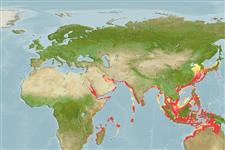Cephalopoda |
Octopoda |
Octopodidae | Octopodinae
Environment: milieu / climate zone / ระดับความลึก / distribution range
นิเวศวิทยา
; ระดับความลึก 30 - 120 m (อ้างอิง 275). Tropical; 41°N - 24°S, 32°E - 143°E (อ้างอิง 275)
Indo-West Pacific: from Mozambique to Red Sea and Japan.
Length at first maturity / ขนาด / Weight / Age
วัยเจริญพันธุ์: Lm ? range ? - ? cm Max length : 10.0 cm ML เพศผู้/กระเทย; (อ้างอิง 275); น้ำหนักสูงสุดที่มีการรายงาน: 400.00 g (อ้างอิง 275)
A small to moderate-sized species recognized by a distinctive color pattern consisting of large, light-colored round patches, separated by dark reticulations over the entire dorsal surface. There is also a light cream-colored longitudinal stripe along the dorsal midline of the mantle.
Maximum total length is 30 cm. Supports subsistence fisheries in East Africa (Ref. 3722). Found in sand and muddy sand areas. Inhabits holes and defends its turf. Solitary with crepuscular behavior (Ref. 101169). Benthic. Inhabits the continental shelf (Ref. 9773).
Life cycle and mating behavior
วัยเจริญพันธุ์ | การสืบพันธุ์ | การวางไข่ | Eggs | ความดกของไข่ | Larvae
Members of the class Cephalopoda are gonochoric. Male and female adults usually die shortly after spawning and brooding, respectively. Mating behavior: Males perform various displays to attract potential females for copulation. During copulation, male grasp the female and inserts the hectocotylus into the female's mantle cavity where fertilization usually occurs. Life cycle: Embryos hatch into planktonic stage and live for some time before they grow larger and take up a benthic existence as adults.
Roper, C.F.E., M.J. Sweeney and C.E. Nauen 1984 FAO Species Catalogue. Vol. 3. Cephalopods of the world. An annotated and illustrated catalogue of species of interest to fisheries. FAO Fish. Synop. 125(3):277p. Rome: FAO. (อ้างอิง 275)
IUCN Red List Status
(อ้างอิง 130435: Version 2025-1)
CITES status (อ้างอิง 108899)
Not Evaluated
CMS (อ้างอิง 116361)
Not Evaluated
Threat to humans
Human uses
การประมง: การค้า
| FishSource |
เครื่องมือ
ข้อมูลเพิ่มเติม
นิเวศวิทยาเขตร้อนFood items (preys)
องค์ประอบของอาหาร
การบริโภคอาหาร
ผู้ล่า
Life cycleการสืบพันธุ์วัยเจริญพันธุ์ความดกของไข่การวางไข่EggsEgg developmentLarvae Human RelatedStamps, coins, misc.
แหล่งที่มาจากอินเตอร์เน็ต
Estimates based on models
Preferred temperature
(Ref.
115969): 18.2 - 28.3, mean 27 (based on 733 cells).
ความสามารถในการกลับคืนสู่ปกติ
ขนาดกลาง, เวลาต่ำสุดที่จะทำให้ประชากรเพิ่มขึ้นเป็น 2 เท่าใช้เวลา 1.4 - 4.4 ปี (K=0.39).
Fishing Vulnerability
Low vulnerability (25 of 100).
